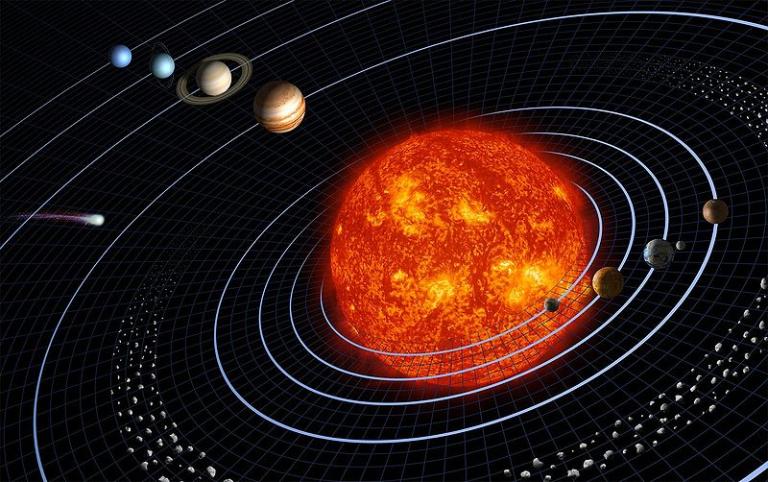
NASA/Jet Propulsion Laboratory
(Wikimedia CC public domain)
Not even remotely to scale, and without the dwarf planet Pluto.
Another passage from Gerald L. Schroeder’s God According to God: A Scientist Discovers We’ve Been Wrong About God All Along (New York: HarperOne, 2009):
After a brief discussion of astronomer Frank Drake’s famous seven-variable equation, from the 1950s, attempting to predict how many planets in our galaxy might host advanced life, Schroeder, who was trained as a planetary scientist and physicist at MIT, proposes to
estimate how many planets in the entire universe might have conditions amenable to advanced, animal-level, carbon-based life. We know that at least one has. We call it the earth. With this approach we avoid having to guess at the likelihood of life starting elsewhere or anywhere. I speak of our concept of complex life as being carbon-based, because carbon is the only one of the ninety-two naturally occurring elements able to form the variety of long-chained, complexly configured molecules associated with life. The environmental conditions required to induce life to start, circumstances that could cause a prebiotic world composed of inanimate rocks, water, and [a] few simple molecules to metamorphose and take on the characteristics associated with the information-packed complexity of life, are a total mystery. Since we have no direct knowledge as to how life started on earth, let’s just explore the characteristics necessary to create an environment amenable to sustaining advanced life, once life has already invented itself.
What might some factors be that would make a domain habitable? Temperature, for a start. The approximate temperature range in our solar system is from 5,500 degrees C on the surface of the sun (15 million degrees C at the center) to minus 270 degrees C at the outer planets. The temperature of space, the minus 270 degrees C, is a mere 3 degrees Kelvin above absolute zero (absolute zero, the temperature at which all molecular motion ceases, is minus 273.2 degrees C, or minus 459.7 degrees F). Life as we know it falls within a temperature range of approximately 100 degrees C, starting at the temperature at which water becomes liquid and ending at its boiling point. That’s 100 out of about 5,800, or 1.7 percent. Of the temperature range experienced in the solar system of sun and planets only 1.7 percent is fit for life. Of course, if we take the total temperature range in the solar system, including the sun’s center, then the slice suitable for life falls to 100 out of 15 million, or one part out of one hundred thousand. That’s a real constraint on positioning. Let’s work with the more life-friendly 1.7 percent. (57-58)
***
Some additional science stuff:
“New Study Suggests Tens of Thousands of Black Holes Exist in Milky Way’s Center”
Time to hit the gym or the track or the swimming pool, it seems:
“Is Alzheimer’s Caused by Poor Blood Flow to the Brain?”
A pair of items on the rather human side of the scientific enterprise:
“Particle Physicists begin to invent reasons to build next larger Particle Collider”
***
A reader calling himself “brotheroflogan” called my attention to this extraordinarily interesting 2016 article yesterday, I believe:
“The Origin of Man and the ‘Waiting Time’ Problem”
Fascinating.











